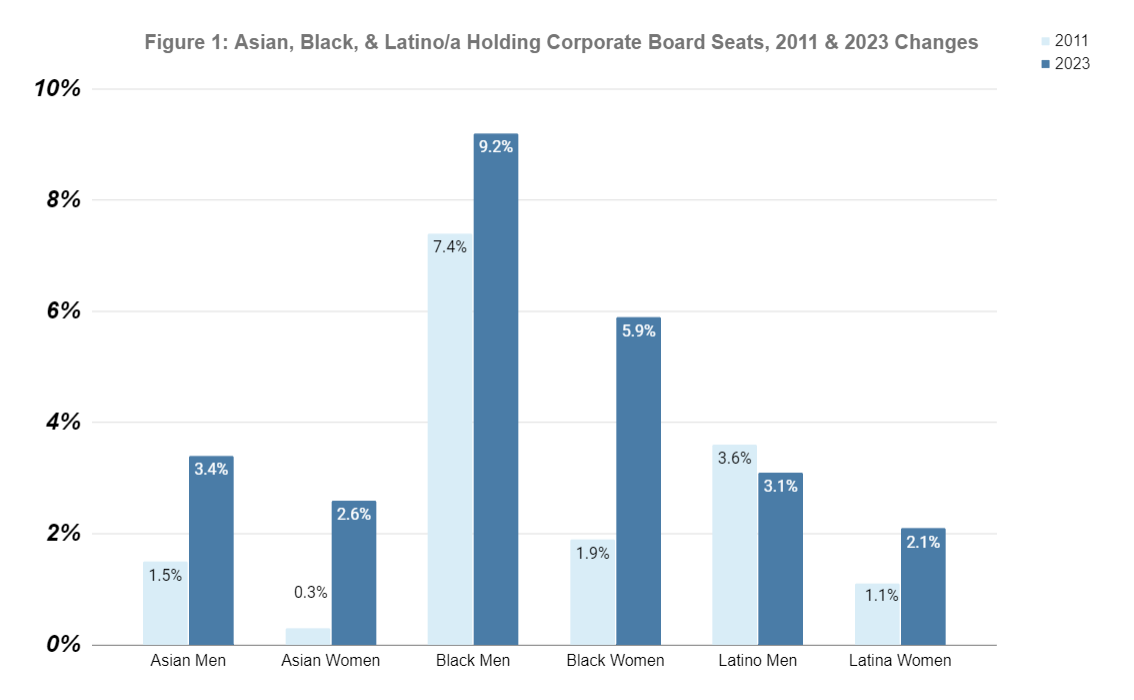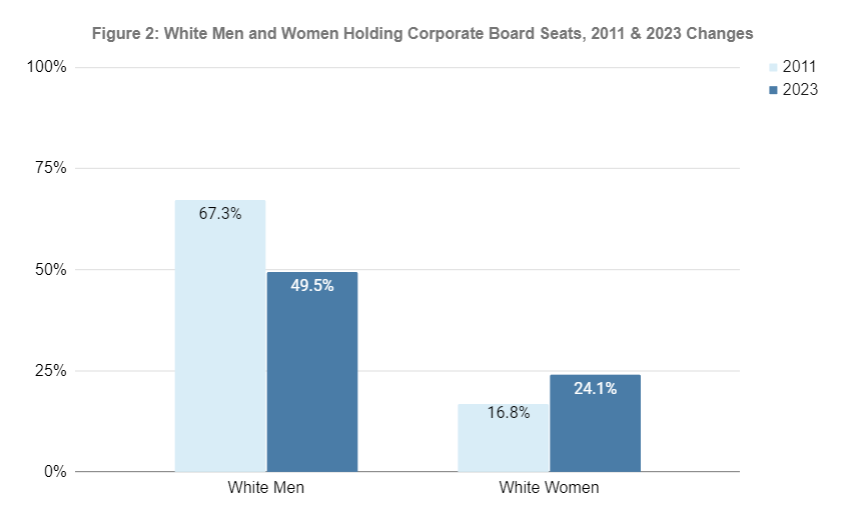
An empty conference table. Image from Pixabay under Pexels license.
In a 2013 article, I wrote that “after decades of efforts to diversify, corporate boards are 87.7% white and 84.5% male” (Zweigenhaft, 2013). Although the make-up of Fortune 500 boards had changed in the previous few decades, they were still very much dominated by white males. Then, after sexual abuse allegations were made against Hollywood film producer Harvey Weinstein, and the acquittal of Trayvon Martin’s murderer, both the “Me Too” and the “Black Lives Matter” movements took off. I decided to look once again at the make-up of Fortune boards.
This time I used only the boards of the top-50 corporations in 2023, and compared them with the make-up of the top-50 companies in 2011. I used only the top 50 corporate boards, not the entire Fortune 500, because there is considerable evidence that the larger corporations have been more likely than the smaller ones to diversify their boards (see, for example, Zweigenhaft and Domhoff, 2006, p. 101, and Zweigenhaft, 2021).
When I compared the top-50 boards in 2011 with the top-50 boards in 2023, with a focus on gender and ethnicity, the results were striking.
First, whereas 84.1% of the directors in the 2011 sample were white, by 2023 that figure had dropped to 73.6%. Second, although 79.8% of the 2011 sample were male, by 2023 that had declined to 65.3%. And third, by 2023 the total of the percentages for white women (24.1%), Blacks (15.1%), Asian Americans (6.1%) and Latinos (5.2%) was a whopping 50.5%—slightly more than half the seats held on these boards (the total was 32.7% in 2011). These changes, which are not trivial, can be seen in Figures 1 and 2.


The data also show that the largest increases were for white women (an increase from 16.8% to 24.1%), Asians (from 1.8% to 6.1%), and Black women (from 1.9% to 5.9%). Notably within the category of Asian men, almost all (17 of 20) were either born in India or of Indian heritage. There was a decrease in percentage of white men (from 67.3% to 49.5%), and, surprisingly and notably, a decrease in the percentage of Latino men (from 3.6% to 3.1%).
Not evident in the figures, but also among the findings, is that most of the directors are quite well educated, some in America and some abroad, and that a sizable minority were not born in America. These findings suggest that Fortune directors are now part of an international, cosmopolitan elite, well-educated men and women from around the world.
Just as the 2011 data did not predict what was to occur over the next 12 years, these findings based on the make-up of the 2023 directors may not be a good predictor of the future make-up of the corporate elite. Indeed, things do not look so hopeful for continued increases in diversity. There was, first of all, the June 2023 Supreme Court decision against affirmative action in higher education. In addition, the states of Texas and Florida have passed legislation that bans public funds being spent on diversity, equity, and inclusion (DEI) initiatives in public higher education (Hassan, 2024). There also has been litigation against the practices some corporations use to address inequality. According to one writer, many big companies were “backing away from efforts to promote diversity, equity and inclusion in their ranks” (Telford, 2023a; see also Telford 2023b). In fact, findings from a study by Spencer Stuart (2023) of the directors of the Standard & Poor’s top 500 companies suggest that there may already have been a tapering off in diversity appointments.
There is more, including data showing that the 14 top-50 Fortune companies in 2023 that had women, African Americans, Asian Americans or Latinos as their CEOs (there were only four in the top-50 in 2010) had much more diversified boards in terms of gender (40% female as opposed to 32%) and ethnicity (30% as opposed to 23%). To see a more complete analysis of the data, and the implications, see the attached pdf or visit the full piece here.
Additional Readings
- Racial Diversity Exposure and Firm Responses Following the Murder of George Floyd Using a text-based measure of a firm’s exposure to racial diversity issues based on conference call transcripts, they find that firms with racial diversity exposure are more likely to appoint Black directors, they are more likely to establish diversity, equity, and inclusion (DEI) departments, appoint DEI leaders, specify diversity goals, increase supply chain diversity, and donate to racial justice causes.
- Gender, Race, and Intersectionality in the Political Donations of America’s Corporate Elite Using a novel longitudinal database, they look at the political donations to U.S. Congressional campaigns from 1980 to 2014. They find that women in the corporate elite are less likely to donate, but are more Democrat-leaning. Men and women of color favor the Democratic Party, and white men are the only reliably Republican constituency within this elite group.
- Diversity among Fortune 500 CEOs from 2000 to 2020: White women, hi-tech South Asians, and economically privileged multilingual immigrants from around the world This article tracks the changes in the makeup of the Fortune 500 CEOs during the first two decades of this century, showing dramatic increases in the number of white women and Indian men.
- Diversity in the Power Elite: Ironies and Unfulfilled Promise This third edition examines the extent to which the corporate, political, and military elites had diversified by 2018, the reasons they had and had not, and some of the ironies that accompanied the changes that had taken place.
